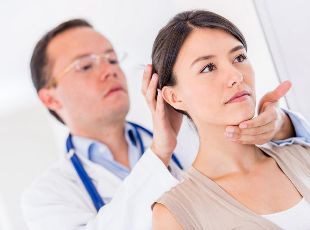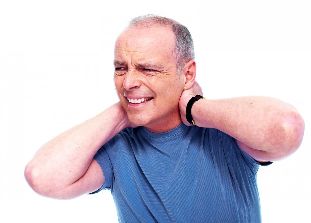Like other diseases of the back, grade 1 cervical osteochondrosis is characterized by pain. The nature of the pain can be called tolerable, but it does not give grounds to leave the disease without seeking medical help and further treatment. Ignoring the symptoms of osteochondrosis, which is still in stage 1, can lead to worsening of the patient's condition and further development of the disease.
Self-medication is not recommended, only an experienced doctor can make the correct diagnosis, determine the cause of the symptoms of the disease and give clear recommendations for dealing with osteochondrosis.
Causes of the disease
Against the background of osteochondrosis of the 1st degree of the cervical spine, in the first place, there is shooting pain, called lumbago. The pain syndrome occurs in the cervical region, in severe cases extends to the shoulders, arms and chest muscles. This happens because the intervertebral discs tend to be injured more when the mobile part of the spine (cervical area) is connected to the less mobile, thoracic region.

The cervical region consists of 7 vertebrae. The first two support the skull, so one can turn his head, tilt and lift it. The vertebrae are connected by joints and removable connections, and the intervertebral discs, consisting of cartilage tissue, serve as a spacer between the vertebrae. Adjacent muscles are also designed to keep the spine upright, if the muscular corset is well developed, the spine will be stable. As you can see, well-coordinated work of the vertebrae, intervertebral discs and muscles ensures healthy functioning of the spine. As soon as a connection from this system begins to function improperly, disturbances occur in the entire work of the spine.
What are the possible causes of disorders and the first symptoms of osteochondrosis:
- sedentary lifestyle;
- excessive physical activity;
- wrong position during sleep;
- nutrition that does not provide the body with a sufficient amount of substances that strengthen the skeletal and muscular systems;
- bad habits;
- stress;
- lack of adequate rest, fatigue;
- frequent hypothermia and colds.
If the muscles that keep the spine in a stable position begin to age and lose tone closer to 50 years - this can be considered normal. But when the cervical spine undergoes a deformity process at the age of 20, it is worth paying attention and taking action. Get preventive treatment, exercise, lead an active lifestyle and avoid sedentary work with a bent neck and back.
Symptoms
In order to list the main signs and symptoms that can accurately determine 1st degree cervical osteochondrosis, it is necessary to clarify the concept itself.
Grade 1 osteochondrosis is the most initial stage of the disease, so far it is characterized only by thickening of the cartilage tissue of the discs between the vertebrae. The spine is still in a stable position, but the hook-shaped processes of the vertebrae are already increasing. Disc displacement is minimal, but its outer sheath, consisting of fibrous tissue, begins to unravel, which, if left untreated, can lead to the development of subsequent stages of osteochondrosis and even an intervertebral hernia.The main symptoms of osteochondrosis of the cervical spine:
- pain syndrome begins in the neck, spreading to the shoulder joints, shoulder blades and chest muscles;
- squeezing the nerve endings leads to the appearance of shooting pain in the neck, especially this condition is aggravated by uncomfortable sleeping position, at night, the patient after waking up keeps his neck in an unnatural position for a long time due to the inability to painlessly turn his head;
- on the background of compression of the nerve roots may occur cardiac syndrome - pain in the chest muscles, which a person confuses with heart pain (examination does not confirm the presence of cardiac pathology);
- due to spinal artery syndrome, the blood supply to the brain and spinal cord deteriorates, which provokes headaches, visual impairment in the form of "flies in front of the eyes", dizziness, pain in the occipital region;
- sleep disorders;
- worry.

The pain syndrome is accompanied by muscle spasm in the area of the affected spine. Grade 1 osteochondrosis of the spine may not provide the symptoms listed, it all depends on the body's sensitivity to pain and the overall well-being of the patient.
With constant fatigue, sedentary work and stress, each of the symptoms of the disease is perceived more acutely. Therefore, the first sign of osteochondrosis - shooting pain in the neck, especially after exercise or hypothermia - should be the reason for a visit to the doctor.
Treatment and prevention
The therapy for cervical osteochondrosis of the 1st degree, first of all, should be aimed at eliminating the pain syndrome and starting active metabolic processes in the tissue of the intervertebral discs. It is also imperative to strengthen the muscular skeleton of the neck to keep the spine in a stable, strong position.
Drug therapy includes the following methods:
- painkillers, anti-inflammatory drugs;
- physiotherapy;
- massage;
- acupuncture;
- medical gymnastics;
- swimming.
With the help of drug therapy it is necessary to relieve pain and inflammation in the affected area, in which case the doctor may combine the appointment of oral anesthetics with injections of vitamin, anti-inflammatory drugs. A good effect is given by the application of external means in the form of warming gels based on painkillers, as well as bee and snake venom.
In addition to drug therapy and physiotherapy can be therapeutic exercises that will help to slightly stretch the spine, release pinched nerve roots and relieve neck pain. Subsequent preventive measures are a healthy, active lifestyle, sports, good nutrition, and avoidance of stress and hypothermia.























